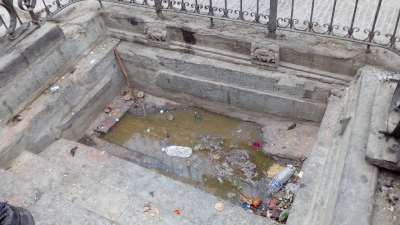It is a pit infront of the Amoghasiddhi Buddha and on the northern side of the Swayambhunath stupa which is rectangular in shape with a snake idol at the bottom of it. It was built to appease the snake spirits in the Kathmandu Valley.
Why Nagpur is made in Swayambhu ?
Once upon a time, the Kingdom of Kathmandu was ruled by King Gunakamadeva. King was more interested in revelry, had abandoned his duties and the Gods was displeased who had been watching from heaven. Gods decided to make him suffer and they withheld the rains, in-order to punish the king. The king gathered all the wise men to find a way to bring back rain to the kingdom. They made several attempts but all failed. Finally, the king visited Swayambhunath to offer his prayers and met the great sage Shantikar Acharya there. The king heard about Shantikar’s magical powers and asked him for help. After listening to the problem Shantikar gave his word to King Gunakamadeva to make preparations. Shantikar found only option open to them is a “Naga Sadhana”. There are different types of sadhanas and Naga Sadhana is performed with the participation of the snake kings known as Nagarajas.
It was a difficult sadhana that can succeed with the co-operation of all the Nagarajas. This sadhana was dependent on the Nagarajas of the valley, all Nagarajas were requested to attend the sadhana. All Nagarajas accepted Shantikar’s invitation except the King of the Nagarajas known as Karkotaka which could not be drawn in his absence. King Gunakamadeva himself went to Karkotaka’s palace several times but Karkotaka keep rejecting his request. This created a problem in the sadhana which was only the way left to bring back rain so, Shantikar advised the King to bring Karkotaka by force and King Gunakamadeva followed his instruction. Finally, they brought the King of the snake to the location of the Naga sadhana.
Shantikar completed his preparations for sadhana, Shantikar painted the mandala carefully and performed sadhana. But the mandala failed to bring the rain back and Shantikar was puzzled by it. He again tried to fix the problem, asked for help with Nagarajas and found the failure reason. He realized that the mandala had to be painted with the blood of the Snake King Karkotaka. The ritual was repeated with the approval of the Snake King. After the completion of sadhan, the rain came down upon the Kathmandu valley.
Time passed by and one day King Gunakamadeva predicted that a drought would destroy his kingdom. He again went to meet Shantikar to get advice. He then advised the king should satisfy the King snake Karkotaka and King ordered to dig a well deep where Karkotaka lived, which took twelve years. During this digging process, the great sage Shantikar and the king repeatedly chanted hymns to praised the King of snakes. Karkotaka was pleased after twelve years and appeared to fulfill their wishes. Karkotaka told them if ever there was a drought in the coming days, they only needed to chant the same hymns that they chanted for twelve years and he would bring the rain. After solving this big problem Shantikar closed the bottom of the well with a large rock.

Many years passed and one day there was a drought in the kingdom as predicted by the King. Now they had an easy way to end up drought, so they tried to remove a large rock that they used to close the well before. But they couldn’t remove the rock to reach Karkotaka place. The king had no option other than to seek help from the sage. From the magical powers of the sage, he found that the problem was caused by the serpent named Tirtha. Serpent Tirtha was jealous of Karkotaka and he wrapped himself around the stone to stop the stone from moving. The great sage forced to remove Tirtha and then it became possible to remove the stone. After removing the stone, they chanted the same hymns which they had chanted for twelve years in the past and again rain began.
After contribution of serpents and their king Karkotaka to end drought in the valley, Nagpur was constructed in tribute to them.
